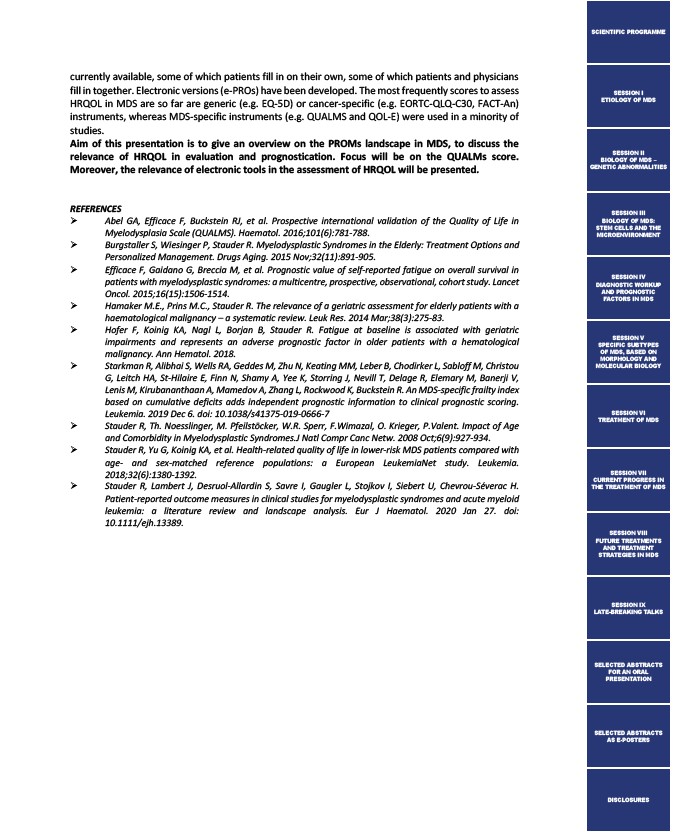
currently available, some of which patients fill in on their own, some of which patients and physicians
fill in together. Electronic versions (e-PROs) have been developed. The most frequently scores to assess
HRQOL in MDS are so far are generic (e.g. EQ-5D) or cancer-specific (e.g. EORTC-QLQ-C30, FACT-An)
instruments, whereas MDS-specific instruments (e.g. QUALMS and QOL-E) were used in a minority of
studies.
Aim of this presentation is to give an overview on the PROMs landscape in MDS, to discuss the
relevance of HRQOL in evaluation and prognostication. Focus will be on the QUALMs score.
Moreover, the relevance of electronic tools in the assessment of HRQOL will be presented.
REFERENCES
Ø Abel GA, Efficace F, Buckstein RJ, et al. Prospective international validation of the Quality of Life in
Myelodysplasia Scale (QUALMS). Haematol. 2016;101(6):781-788.
Ø Burgstaller S, Wiesinger P, Stauder R. Myelodysplastic Syndromes in the Elderly: Treatment Options and
Personalized Management. Drugs Aging. 2015 Nov;32(11):891-905.
Ø Efficace F, Gaidano G, Breccia M, et al. Prognostic value of self-reported fatigue on overall survival in
patients with myelodysplastic syndromes: a multicentre, prospective, observational, cohort study. Lancet
Oncol. 2015;16(15):1506-1514.
Ø Hamaker M.E., Prins M.C., Stauder R. The relevance of a geriatric assessment for elderly patients with a
haematological malignancy – a systematic review. Leuk Res. 2014 Mar;38(3):275-83.
Ø Hofer F, Koinig KA, Nagl L, Borjan B, Stauder R. Fatigue at baseline is associated with geriatric
impairments and represents an adverse prognostic factor in older patients with a hematological
malignancy. Ann Hematol. 2018.
Ø Starkman R, Alibhai S, Wells RA, Geddes M, Zhu N, Keating MM, Leber B, Chodirker L, Sabloff M, Christou
G, Leitch HA, St-Hilaire E, Finn N, Shamy A, Yee K, Storring J, Nevill T, Delage R, Elemary M, Banerji V,
Lenis M, Kirubananthaan A, Mamedov A, Zhang L, Rockwood K, Buckstein R. An MDS-specific frailty index
based on cumulative deficits adds independent prognostic information to clinical prognostic scoring.
Leukemia. 2019 Dec 6. doi: 10.1038/s41375-019-0666-7
Ø Stauder R, Th. Noesslinger, M. Pfeilstöcker, W.R. Sperr, F.Wimazal, O. Krieger, P.Valent. Impact of Age
and Comorbidity in Myelodysplastic Syndromes.J Natl Compr Canc Netw. 2008 Oct;6(9):927-934.
Ø Stauder R, Yu G, Koinig KA, et al. Health-related quality of life in lower-risk MDS patients compared with
age- and sex-matched reference populations: a European LeukemiaNet study. Leukemia.
2018;32(6):1380-1392.
Ø Stauder R, Lambert J, Desruol-Allardin S, Savre I, Gaugler L, Stojkov I, Siebert U, Chevrou-Séverac H.
Patient-reported outcome measures in clinical studies for myelodysplastic syndromes and acute myeloid
leukemia: a literature review and landscape analysis. Eur J Haematol. 2020 Jan 27. doi:
10.1111/ejh.13389.
SCIENTIFIC PROGRAMME
SESSION I
ETIOLOGY OF MDS
SESSION II
BIOLOGY OF MDS –
GENETIC ABNORMALITIES
SESSION III
BIOLOGY OF MDS:
STEM CELLS AND THE
MICROENVIRONMENT
SESSION IV
DIAGNOSTIC WORKUP
AND PROGNOSTIC
FACTORS IN MDS
SESSION V
SPECIFIC SUBTYPES
OF MDS, BASED ON
MORPHOLOGY AND
MOLECULAR BIOLOGY
SESSION VI
TREATMENT OF MDS
SESSION VII
CURRENT PROGRESS IN
THE TREATMENT OF MDS
SESSION VIII
FUTURE TREATMENTS
AND TREATMENT
STRATEGIES IN MDS
SESSION IX
LATE-BREAKING TALKS
SELECTED ABSTRACTS
FOR AN ORAL
PRESENTATION
SELECTED ABSTRACTS
AS E-POSTERS
DISCLOSURES